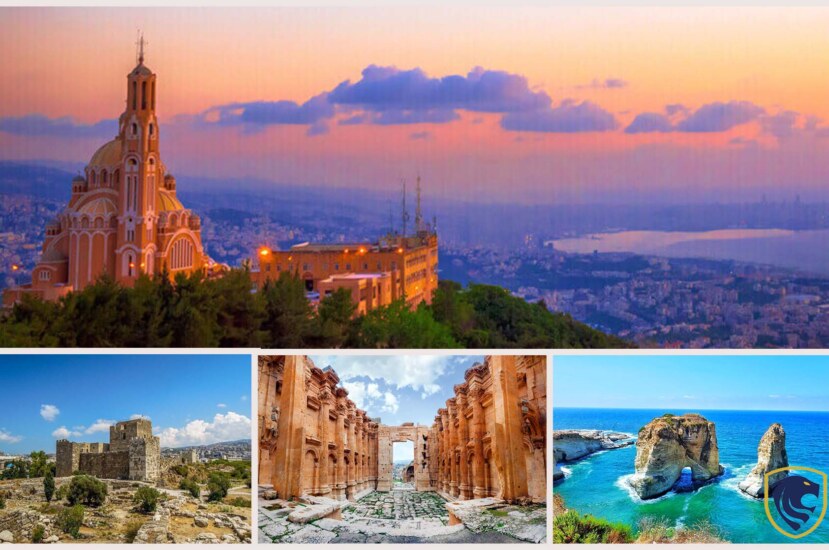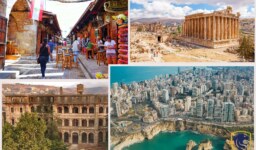Welcome to the enchantment that is Lebanese tourism, where ancient history collides with dynamic contemporary. Lebanon, located on the Mediterranean coast, is a treasure mine of unique experiences. Every area provides a unique journey, from the frenetic streets of Beirut, a city that never sleeps, to the tranquil serenity of Qadisha Valley. So, explore Baalbek’s ancient treasures, Jeita Grotto’s underground wonders, and Harissa’s spiritual refuge. In traditional souks, savor the aromas of Lebanese food while seeing the wonderful blend of ancient ruins and vibrant culture. Tourism in Lebanon welcomes you on a trip through time, art, nature, cuisine, and spirituality, guaranteeing wonderful experiences in a place where every day is a new adventure.
Beirut
Beirut, the dynamic hub of Lebanon, is a mesmerizing combination of history and contemporary. The spirit of the city is contagious, as seen by its lively markets, hip cafés, and historic sites. Moreover, Pigeons’ Rock, which protrudes abruptly from the Mediterranean, is a symbol of Beirut’s tenacity. The Corniche, is a picturesque beachfront promenade, with panoramic views of the sea and mountains. Downtown Beirut is home to the brilliant Mohammad Al-Amin Mosque and the ancient Nejmeh Square, as well as exquisite French-inspired buildings. The National Museum of Beirut exhibits Phoenician antiquities as part of Lebanon’s rich archeological legacy.

Beirut
Mar Mikhael, a fashionable district, is brimming with art galleries, vibrant street art, and chic stores. The Sursock Museum, a converted 19th-century palace, exhibits contemporary and modern Lebanese art. Also, Beirut’s nightlife is famed, with rooftop bars and clubs keeping the city going into the wee hours of the morning. Beirut is a gastronomic heaven, with flavors ranging from traditional mezze to foreign cuisines. The city’s resiliency after the civil war is mirrored in its vibrant environment, making it a must-see trip in Lebanon.
Byblos
Byblos, one of the world’s oldest continually inhabited cities, is a historical treasure trove in Lebanon. Its historic port and scenic waterfront contribute to the attractive environment. The city is rich in ancient treasures, including the Crusader Castle and Phoenician remains. Byblos is notable for its antique souks, which are filled with traditional crafts and souvenirs. Furthermore, the city’s renowned St. John the Baptist Church is a reminder of its Christian roots. Byblos is well-known for its music, arts, and cultural events.

Byblos
The city’s Archaeological Site and Wax Museum provide views into its colorful history. Also, the Byblos Worldwide Festival, which features prominent worldwide performers, is held in Byblos. Moreover, the Byblos Fossil Museum displays fossils going back millions of years, making for an interesting educational experience. The busy nightlife of Byblos comprises beach restaurants and bars, providing a dynamic scene. Visitors may unwind on Byblos’ sandy beaches and soak up the Mediterranean sun. In conclusion, Byblos is a living history book that invites visitors to immerse themselves in Lebanon’s rich past.
Baalbek
The UNESCO World Heritage Site of Baalbek is an awe-inspiring archeological treasure in Lebanon. It was known as Heliopolis in ancient times and is home to some of the world’s best-preserved Roman ruins. In addition, the huge pillars of the Temple of Jupiter are a monument to Roman technical brilliance. The Temple of Bacchus, devoted to the deity of wine, is a magnificent structure with elaborate sculptures.

Baalbek
The site also comprises the Venus Temple, the Mercury Temple, and the magnificent Great Court. The history of Baalbek stretches back millennia, with influences from the Phoenician, Roman, and Byzantine civilizations. The historical significance and architectural marvels of the site attract archaeology and history aficionados from all over the world.
The yearly Baalbek International Festival features cultural activities and music amid these historic wonders, creating a dreamlike atmosphere. Also, the majesty of the place, situated against the backdrop of Lebanon’s mountains, inspires awe and adoration. So, visiting Baalbek is a remarkable experience that provides a look into the grandeur of ancient civilizations and the continuing heritage of Lebanon’s past.
Jeita Grotto
Jeita Grotto, a natural beauty situated amid Lebanon’s limestone highlands, is enthralling. It’s a fascinating labyrinth of stalactites and stalagmites made up of two interconnecting caverns. The bottom cave transports guests on a boat journey via an underground river, exposing the ethereal splendor of the grotto. In addition, the top cave features a walking tour that highlights fascinating formations that have formed over millions of years.
The chambers of the grotto are embellished with colorful formations, creating a dreamlike environment. Moreover, the Cathedral Hall is a marvel, with its lofty ceilings and crystalline forms. Jeita Grotto’s underground spectacular has been named one of the New Seven Wonders of Nature contenders.

Jeita Grotto
The grotto’s magical aura, a realm concealed under the earth’s surface, captivates visitors. The location has been scrupulously kept, allowing visitors to see nature’s artwork up close. Also, the Jeita Grotto is more than simply a geological marvel; it is a tribute to the Earth’s creative powers and a must-see site for visitors exploring Lebanon’s natural beauties.
Harissa
Harissa is a pilgrimage place and a spectacular perspective perched atop Lebanon’s hills. It is the location of the famed Our Lady of Lebanon statue, which is a symbol of peace and spirituality. Visitors ascend via cable car, taking in panoramic views of the Mediterranean shoreline and rugged terrain. Furthermore, the place is a spiritual refuge, attracting both devout and visitors. The monument, which stands magnificently against the sky, exudes peace and devotion.

Harissa
Aside from its religious importance, Harissa is a peaceful retreat. The adjacent grounds encourage calm walks and introspection. In addition, local traders sell religious relics and souvenirs, adding to the appeal of the location. The St. Paul Basilica, which lies nearby, draws history buffs with its interesting architecture.
The appeal of Harissa continues into the evening when the sun sets, creating a golden light on the monument and the sea below. The beauty of the location is not just in its religious significance, But also in the sense of tranquility it provides. Harissa, whether for spiritual introspection or panoramic views, is a tribute to Lebanon’s cultural diversity and natural grandeur, making it a must-see site in the country.
Qadisha Valley
The Qadisha Valley, also known as the Holy Valley, is a scenic wonder in Lebanon. This UNESCO World Heritage Site is a spiritual and environmental refuge. The valley is surrounded by cliffs and craggy mountains, producing a striking scene. Also, the valley is lined with historic monasteries, some of which date back to the early Christian era. These monastery villages, located on cliffsides, merge with the natural splendor of the valley.
Hikers and environment lovers are drawn to Qadisha’s tranquil atmosphere. Trails wind through the forest and along the cliffs, providing panoramic views of the valley below. The valley provides a haven for a variety of animals, including rare bird species, which adds to its attraction.

Qadisha Valley
Architectural marvels, such as the Monastery of Qozhaya and the Monastery of St. Anthony of Qozhaya, reflect historic Christian history. During stormy times, the valley served as a haven for academics, conserving information.
The profound historical roots of Qadisha Valley, together with its awe-inspiring vistas, make it a magnet for tourists seeking a mix of cultural legacy and natural beauty. It’s a location where the echoes of old prayers blend with the rustling leaves, producing a one-of-a-kind and rewarding experience for those who explore its depths.




